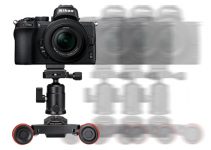The market for Large Format, high-end cameras has grown recently with new offerings from Canon, Sony, and ARRI. There is no denying the stunning results a skilled cinematographer can acquire with these remarkable LF cameras.
LF and Full Frame quickly became ‘the’ quality standard for big-budget films, and commercial projects. But as it is with all cutting-edge technology, it was generally out of the range of the common cameraman.
With the introduction of the ARRI ALEXA LF Mini, the Sony Venice, the Sony FX9, and the Canon C500 II, the playing field is starting to level and that awe-inspiring, professional LF look is starting to get within reach.
Seasoned filmmaker Kenny McMillan and Stray Angel Films were kind enough to give us their take on these four cameras. Have a gander at what they have put together – a great video, and a link to samples you can download to help you determine which one might be right for your project.
Sensor technology is so good these days that declaring any of these cameras the winner based purely on specs is next to impossible. They all have their positives and negatives, and on each those pluses and minuses almost completely outweigh one another.
Personally, I’m biased and I’d like to be honest and upfront with you that I do not like Sony’s color science on their low-to-mid-tier cameras. Though it was incredibly popular, I find the Sony FS7’s look to be absolutely awful in post. The FX9 is an upgrade to that and it bares a resemblance to its older sibling. However, I’ve always been fond of the look of the F5/F55 – the Venice definitely builds on that.
Setting my partiality aside, let’s have a look at the specs. *Lowest to highest priced.
SONY FX9 (B&H, Amazon)
- 6K Full-Frame Exmor R CMOS Sensor
- UHD 4K up to 59.94p
- 15 Stops of Dynamic Range
- Built-In ND Filter: 4 to 128 Stop Electronic
- Sony Catalyst Post Stabilization
- HD Recording up to 120fps
- RAW with optional recorder
- $10.998 (Body) / $13,498 (w/ 28-135mm Lens Kit)
Aside from it’s rock-solid autofocus system (which I think professionals tend to forget about and they shouldn’t), this is spec’ed at the bottom of the pack. It’s well priced, and will roll nicely into your productions if you’re currently filming with the FS7.
It can capture a wonderful LF image, and the E-Mount lens system can be adapted to almost any lens. But it’s also rather limited for 2020 in terms of its recording options, and use of external modules. It uses a 6K LF sensor which is downsampled to 4K. This isn’t a bad thing but this is a UHD camera. It isn’ a 6k camera or even a 4k DCI camera.
Canon C500 II (B&H)
- Full-Frame 5.9K CMOS Sensor
- DIGIC DV 7 Chip
- DCI 4K/2K, UHD 4K, and HD Modes
- Full-Frame, Super 35, Super 16 Modes
- 5-Axis Electronic Stabilization
- Built-In ND Filter 2,4,6,8,10 Stop
- 15 Stops of Dynamic Range
- Cinema RAW Light 10-bit, 12-bit
- XF-AVC (160-810 MB/s)
- $15,999.00
The Canon C500 Mk II boasts a beautiful full-frame sensor (the same as the C700) with Canon’s rock-solid Dual Pixel Auto Focus (DPAF). DPAF is nice to have on a S35 camera, and I feel it’s an absolute must when shooting in Full Frame without a 1st AC to pull focus.
Its feature set is all around better than what’s offered internally in the FX9 (again, aside from the AF; Sony’s AF in the FX9 is stellar), and this is the umpteenth time I’ve seen someone compare the image of Canon Cinema Raw Light (from the C500 II or the C200) to the gold standard, Arri Alexa. I would argue that the camera itself is a superior choice for a solo shooter or doc shooter since it’s smaller and offers more features to improve your workflow.
Cinema Raw Light, however, is a real drain on processing power in post. It really tanked the adoption of the C200 in certain markets with the added processing time. CRM is a joy to grade but those files really make even the fastest computers chug along, and that can be a real problem when turn around times are tight.
Sony VENICE (B&H)
- Full-Frame CMOS Sensor
- UHD 4K and DCI 4k Capture
- 6K 2.39:1 and 5.7K 16:9 (w/ Full-Frame License)
- 15+ Stops of Dynamic Range
- Built-In ND Filter 1,2,3,4,5,6,7,8 Stop
- $42,000 (body)
This is a workhorse camera that produces an absolutely beautiful LF image. It is entirely at home on film sets, documentary shoots, commercials, you name it. The color and image quality are the absolute best, top-of-the-line that Sony has to offer and it shows.
It boggles my mind, however, that in 2020 with a $42,000 price tag that 6K & 5.7K are only available with the purchase of an additional license. It reminds me of the 2014 Sony F5 hack; where Cinematographer Paul Ream discovered that Sony had crippled its F5 camera to protect its higher priced F55. If you recall, Ream learned that simply manually editing a few settings on a file allowed the F5 to shoot 4K too.
This is their flagship professional camera – everything should be included and more.
Arri Alexa Mini LF
- ALEXA LF Sensor
- UHD up to 60fps
- ARRIRAW & ProRes
- Built-In ND 2,4,6 Stop
- 14+ Stops of Dynamic Range
- $58,760
The ARRI ALEXA Mini LF is a smaller version of what is undoubtedly the king of cameras. It uses ARRI’s beautiful LF sensor, which is so good that for years every camera big and small has been held in comparison to it. This is Hollywood’s go to for filmmaking, and many of the Oscar-nominated films for the past several years have been filmed using an ARRI ALEXA.
It can shoot in 4K UHD at up to 60fps, is Netflix approved unlike it’s little brother the Arri Alexa, which shoots 4K scaled up from 3K, and can record in both ARRI RAW and ProRes. This stripped down Mini is missing some of the features you’d find in the ALEXA LF but its compact size makes it easier to rig.
Conclusion
All of these are great LF/Full-Frame cameras for professional cinematography. There is a slight shift in the colors of the Sony cameras that can be easily dialed out in post, but otherwise, it would be next to impossible for any viewer to know the difference between these cameras as long as they’re in the hands of the right cinematographer. The choice to use one over the other will likely come down to lenses, shoot requirements for integrated systems (such as audio), and obviously price.
If I had to choose, my pick would be the Canon C500 II. Its price, feature set, and usability are perfect for nearly any situation. Time and time again, we hear how easy it is to match Canon’s Cinema Raw Light with the ARRI ALEXA, but it’s also pretty easy to match it to Sony, RED, and Panasonic which opens up a world of possibilities for A & B cameras.
Canon, who has historically been slightly behind the curve, really upped their game with the C500 II and are continuing to push themselves with the release of the C300 III and even the 8K capable EOS R5. There are a lot of exciting things going on with Canon lately, and I don’t think those changes in attitude should be overlooked.
For this comparison, however, I feel like it is a total wash. Pick the one you like best (that fits your budget), and you’ll come back with something fantastic. Just remember to shoot slightly overexposed (also known as ETTR/Expose To The Right) and correct your image in post to get the best possible image. Underexposing any of these cameras will add noise and sometimes color issues.
Finally, you can check out McMillan’s article and his insights on the topic here. Share your thoughts. I’m interested in getting your opinions on these four cameras.
[source: Stray Angel Films]
Disclaimer: As an Amazon Associate partner and participant in B&H and Adorama Affiliate programmes, we earn a small comission from each purchase made through the affiliate links listed above at no additional cost to you.



